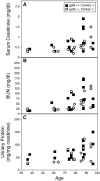Gelatinase B (MMP-9) is not essential in the normal kidney and does not influence progression of renal disease in a mouse model of Alport syndrome
- PMID: 10880400
- PMCID: PMC1850218
- DOI: 10.1016/S0002-9440(10)64541-5
Gelatinase B (MMP-9) is not essential in the normal kidney and does not influence progression of renal disease in a mouse model of Alport syndrome
Abstract
Matrix metalloproteinases are matrix degrading enzymes implicated in many biological processes, including development and inflammation. Gelatinase B (gelB; also known as MMP-9) is expressed in the kidney and is hypothesized to be involved in basement membrane remodeling and in preventing pathogenic accumulation of extracellular matrix in the kidney. Inhibition of gelB activity in metanephric organ culture disrupts branching morphogenesis of the ureteric bud, suggesting that gelB plays a role in kidney development in vivo. We studied kidneys of gelB-deficient mice to search for developmental, histological, molecular, ultrastructural, and functional defects. Surprisingly, no differences between gelB-/- and control kidneys were detected, and renal function was normal in gelB mutants. In addition, gelB-/- embryonic kidneys developed normally in organ culture. Gelatinase B-deficient mice were bred with Col4a3-/- mice, a model for Alport syndrome, to determine whether gelB influences the progression of glomerulonephritis. This is an important question, as it has been hypothesized that proteases are involved in damaging Alport glomerular basement membrane. However, the presence or absence of gelB did not affect the rate of progression of renal disease. Thus, gelB does not have a discernible role in the normal kidney and gelB is not involved in the progression of glomerulonephritis in a mouse model of Alport syndrome.
Figures








Similar articles
-
Stage-specific action of matrix metalloproteinases influences progressive hereditary kidney disease.PLoS Med. 2006 Apr;3(4):e100. doi: 10.1371/journal.pmed.0030100. Epub 2006 Mar 7. PLoS Med. 2006. PMID: 16509766 Free PMC article.
-
Increased expression of MMP-2, MMP-9 (type IV collagenases/gelatinases), and MT1-MMP in canine X-linked Alport syndrome (XLAS).Kidney Int. 2003 May;63(5):1736-48. doi: 10.1046/j.1523-1755.2003.00939.x. Kidney Int. 2003. PMID: 12675849
-
Collagen receptors integrin alpha2beta1 and discoidin domain receptor 1 regulate maturation of the glomerular basement membrane and loss of integrin alpha2beta1 delays kidney fibrosis in COL4A3 knockout mice.Matrix Biol. 2014 Feb;34:13-21. doi: 10.1016/j.matbio.2014.01.006. Epub 2014 Jan 27. Matrix Biol. 2014. PMID: 24480069
-
[Molecular genetics of Alport syndrome].Nihon Rinsho. 1992 Dec;50(12):3021-6. Nihon Rinsho. 1992. PMID: 1491454 Review. Japanese.
-
Choosing a mouse model to study the molecular pathobiology of Alport glomerulonephritis.Kidney Int. 2007 Apr;71(7):615-8. doi: 10.1038/sj.ki.5002115. Epub 2007 Feb 7. Kidney Int. 2007. PMID: 17290292 Review.
Cited by
-
Stage-specific action of matrix metalloproteinases influences progressive hereditary kidney disease.PLoS Med. 2006 Apr;3(4):e100. doi: 10.1371/journal.pmed.0030100. Epub 2006 Mar 7. PLoS Med. 2006. PMID: 16509766 Free PMC article.
-
MMP-9 gene deletion mitigates microvascular loss in a model of ischemic acute kidney injury.Am J Physiol Renal Physiol. 2011 Jul;301(1):F101-9. doi: 10.1152/ajprenal.00445.2010. Epub 2011 Mar 30. Am J Physiol Renal Physiol. 2011. PMID: 21454251 Free PMC article.
-
Matrix metalloproteinase 9 protects mice from anti-glomerular basement membrane nephritis through its fibrinolytic activity.J Exp Med. 2001 Apr 2;193(7):793-802. doi: 10.1084/jem.193.7.793. J Exp Med. 2001. PMID: 11283152 Free PMC article.
-
Molecular Basis, Diagnostic Challenges and Therapeutic Approaches of Alport Syndrome: A Primer for Clinicians.Int J Mol Sci. 2021 Oct 14;22(20):11063. doi: 10.3390/ijms222011063. Int J Mol Sci. 2021. PMID: 34681722 Free PMC article. Review.
-
Collagen IV diseases: A focus on the glomerular basement membrane in Alport syndrome.Matrix Biol. 2017 Jan;57-58:45-54. doi: 10.1016/j.matbio.2016.08.005. Epub 2016 Aug 27. Matrix Biol. 2017. PMID: 27576055 Free PMC article. Review.
References
-
- Matrisian LM: Metalloproteinases and their inhibitors in matrix remodeling. Trends Genet 1990, 6:121-125 - PubMed
-
- Birkedal-Hansen H, Moore WG, Bodden MK, Windsor LJ, Birkedal-Hansen B, DeCarlo A, Engler JA: Matrix metalloproteinases: a review. Crit Rev Oral Biol Med 1993, 4:197-250 - PubMed
-
- Stetler-Stevenson WG, Aznavoorian S, Liotta LA: Tumor cell interactions with the extracellular matrix during invasion and metastasis. Annu Rev Cell Biol 1993, 9:541-573 - PubMed
-
- Shapiro SD: Mighty mice: transgenic technology “knocks out” questions of matrix metalloproteinase function. Matrix Biol 1997, 15:527-533 - PubMed
-
- Vu TH, Werb Z: Gelatinase B: structure, regulation, and function. Parks WC Mecham RP eds. Matrix Metalloproteinases. 1998, :pp 115-148 Academic Press, San Diego
Publication types
MeSH terms
Substances
Grants and funding
LinkOut - more resources
Full Text Sources
Other Literature Sources
Medical
Molecular Biology Databases
Miscellaneous

